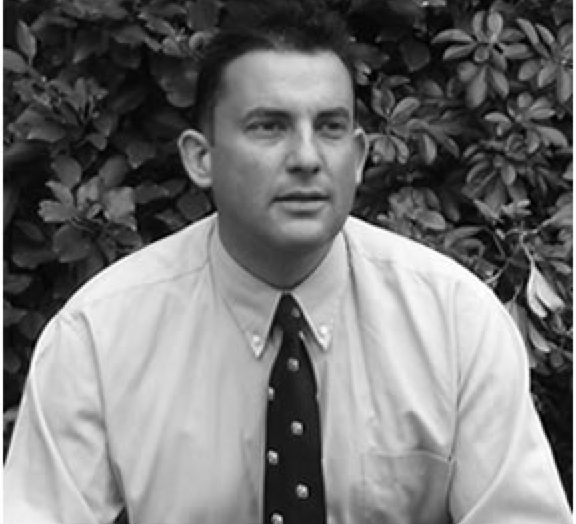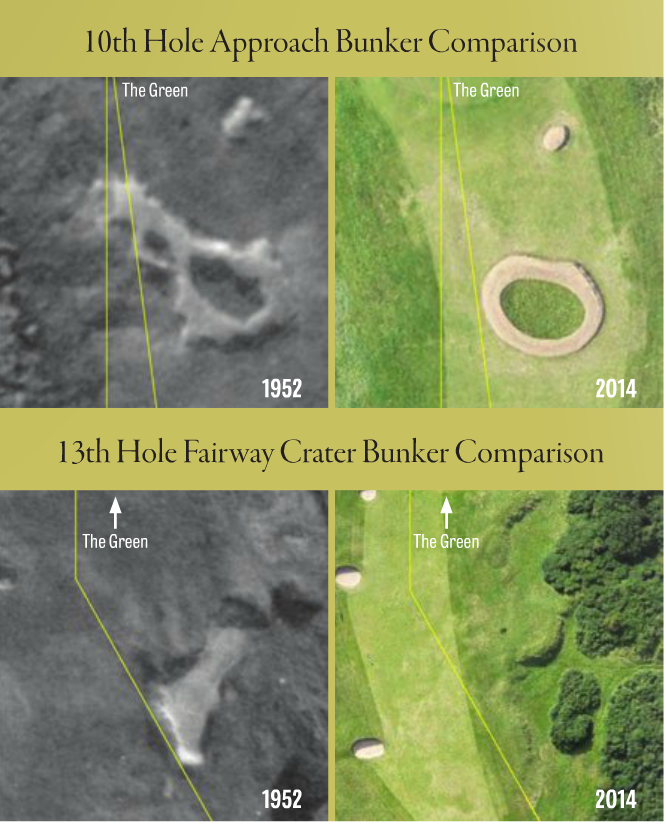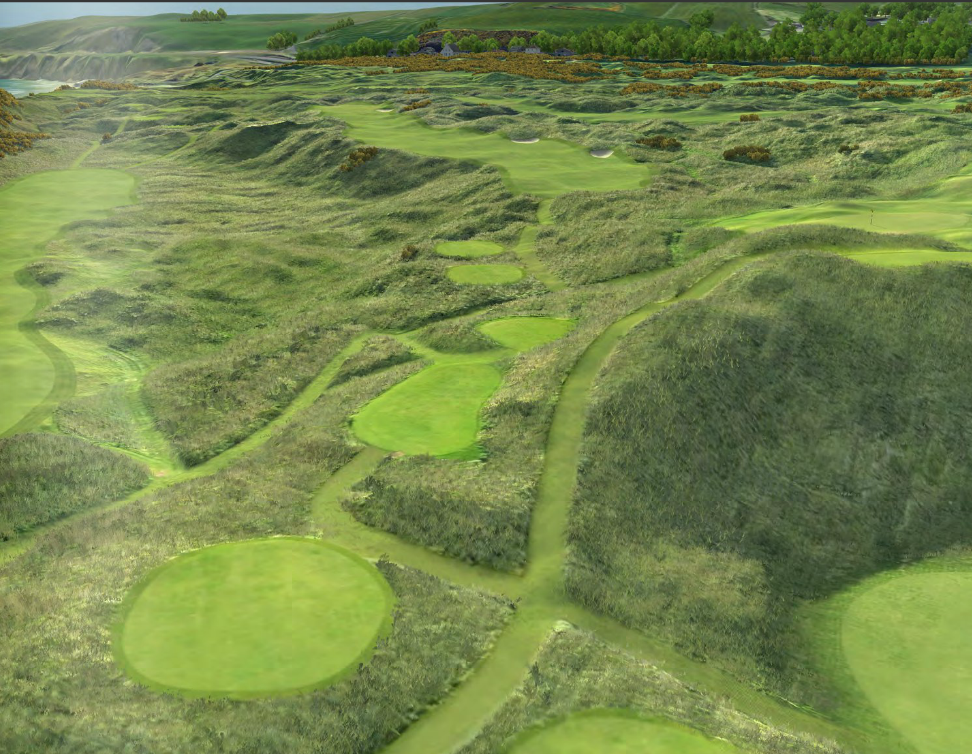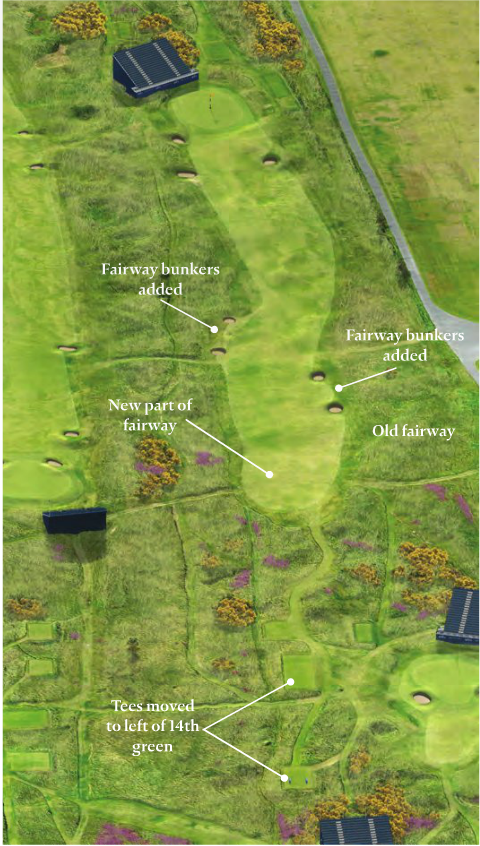Q&A With Golf Architect Martin Ebert
/The firm of Mackenzie & Ebert, founded in 2005, has been entrusted with some of the world's most important links. The former staff members of Donald Steel's firm have proven up to the task of addressing difficult issues while leaving behind architectural touches that restore and embellish.
 I was fearful that any Cruden Bay tinkering could be problematic, but Tom Mackenzie made the 9th hole significantly better, injecting several new elements to form a more dramatic hole befitting the epic location of that short par-5. A new tee angle at the 10th improved the look and feel of the tee shot, while addressing a safety matter brought on by modern technology.
I was fearful that any Cruden Bay tinkering could be problematic, but Tom Mackenzie made the 9th hole significantly better, injecting several new elements to form a more dramatic hole befitting the epic location of that short par-5. A new tee angle at the 10th improved the look and feel of the tee shot, while addressing a safety matter brought on by modern technology.
Mackenzie's design partner, Martin Ebert, kindly took time to give us insights into three links he has worked at and which are very much on the minds of golfers: Turnberry, Royal Portrush and Royal Troon.
As The Open gets underway at Troon, Ebert fills us in on the work done at these three landmark courses. I'll be posting a ful Turnberry review after an evening round in the rain. In short, the transformation is magnificent. But in the meantime, please enjoy his thoughts as well as links to Mackenzie and Ebert's groundbreaking use of presentation graphics.
GS: What would be the best description for the work at Turnberry: redesign, modernization, restoration, renovation or some combination of all? ME: That is an excellent question as there is a combination of all of the descriptions which could apply.
ME: That is an excellent question as there is a combination of all of the descriptions which could apply.
'Redesign' can definitely be applied as we have, I would say, 5 completely new holes within the layout. The 6th is really a new par 3, having new tees and a new green in different locations and the hole is a much shorter par 3 than it was before. The 9th is a new par 3, albeit played from the same general teeing area as the old, hog's back par 4. The 10th has been extended to a par 5 with new back tees and a new green so I would claim that this is really a new hole. The 11th is a new par 3 occupying a different piece of ground than the old hole. Finally the 14th is routed into completely new land from tees in a similar location to the old hole and the hole is now a par 5 rather than a par 4. A case could even be made for the 1st being a new hole as well as the tees and green have both been extended backwards and the landing area bunkering has been reconfigured. So I think that the changes would constitute redesign.
'Modernization' also applies as I believe that we have made the course fit to test the greatest players in the world and the way that they play the game from a range of new tees and green locations. Some of the changes would not have been possible in years gone by. The players would not have carried the ball far enough to take on the new tee shots at the 9th and 10th holes for instance. However, the course needs to meet the modern demands of average club member and visitor play as this will be the use of The Ailsa for 99% of its time.
In pursuit of that, I believe that we have made the course more 'fit for purpose' as it should now be more enjoyable for the vast majority of golfers. They now have five par 3s to play and almost all golfers love playing par 3s, and we have added two par 5s to the front nine, leading to four in total, which makes the 5th and the 7th holes, previously par 4s, much more playable. In another way we have modernized the course by providing more flag positions on many of the greens. Higher green speeds have meant, as with all courses, that some areas of greens which used to be suitable for flag positions no longer are. That was especially the case at Turnberry where many of the greens had a 'bowl' like shape with the edges of the greens just too sloping to be useable. We have softened some of these areas to provide some exciting new flag locations which will use the edge features of bunkers, links banks and swales much more than before. An example is the par 3 15th hole where the flag can now be located much closer to the dangerous bank to the right of the green.
As far as 'Restoration' is concerned, my advice to Mr Trump when we embarked upon the project was that we should conduct as thorough a study as possible of the evolution of the course and especially following its reincarnation immediately after the Second World War. This proved to be a fascinating exercise when we compared the aerial photographs from just before Philip Mackenzie Ross carried out his work to just after it was completed. The photographs showed completely different bunker shapes and it was also clear that the bunkers had rough edges rather than revetted edges. In fact, the rough edges survived until the 1980s. Hence our recommendation was to restore the shapes of the bunkers where appropriate and to restore the rough edged character to the fairway bunkers. The greenside bunkers have new plan shapes to reflect the old forms but are revetted which was preferred by The R&A. Now that the project is completed I think that the two styles sit well with one another.
Finally, 'Renovation' also applies as every tee, green and bunker has been reconstructed. The greens have been built with a much sandier root zone created by mixing the old green root zone with dune sand to provide much more free draining surfaces which will be easier to manage in the long term to produce firmer and finer greens. The tees have been formed using the old green root zone and the bunker drainage as well as general fairway drainage has been improved.
(A full study and the rationale behind the changes can be viewed in this booklet and video.)
GS: Turnberry has produced some of golf's most thrilling finishes, did this put any added pressure on you in approaching how to re-imagine the links?
ME: I am not sure this added any pressure but we did want to respect those wonderful Open finishes as far as possible. For instance, we chose to retain the 18th green surface exactly as it was before the work started given the historic moments of the Duel in the Sun in 1977 and the sad events of 2009 although the green surrounds have had a little more feature added.
There were some misgivings about changing the 17th green. I imagine that Nick Price will be a little disappointed that the scene of his great eagle putt is no longer. However, hopefully he will understand that the greater cause of the major layout change to produce a straightened 18th hole for championship play justifies this.
One of the key changes to the course has been that straightening of the 18th hole for championship play. Previously the hole was a sharp and rather unnatural dogleg. The spectators in the 18th green grandstands would only get a view of the players at the corner of the dogleg. Now they will see the players silhouetted on the tee located on the dune bank with the ocean as the backdrop. The golfers will be taking aim on some part of the iconic hotel. So hopefully we will have set an even better scene for more thrilling finishes. However, that did mean shortening the 17th hole to a par 4 but it also had the knock on effect of requiring a new par 5 at the 14th hole and the new, shortened par 3 6th hole.
GS: Tell us about what has happened with the pitch-and-putt course, The Wee Links?
ME: The pitch and putt course has been completely rebuilt and now provides the hotel with a real links like setting immediately below it. The pitch and putt course used to have more of a garden feel to it and the greens were tiny. You had to be a good player to have any chance of hitting the greens. There was also a tennis court within the area which detracted from the view from the hotel. We imported a lot of on site fill material and shaped this up into what could be described as a large scale Himalayas (St Andrews) landscape with some bunkers included. Apart from recovery from the bunkers, a complete non golfer can now play the course with a putter. There are no set tee positions so the tee markers can be placed wherever suits. There are 18 greens (two are double greens) but the course could be played as 18 holes, 12 holes, 9 holes or even 6 holes by simply removing some of the flags and hence creating longer or shorter holes.
GS: The Arran Course is also slated for a redesign, what can you tell us about the plans?
ME: I assume that you mean the Kintyre Course although the second course used to be called the Arran. There is a lot of change here too to the extent that the course will be renamed. We are currently working on the changes. Mr Trump is currently considering some alternatives for this. The jewel in the crown of the landform is Bains Hill at the furthest point from the hotel and clubhouse. This coastal hillside will have its three holes reversed in direction to make maximum use of the views to the ocean and the existing 11th will be extended to a par 5 with an aiming point directly upon the Lighthouse. The direct coastal stretch will be the home of an incredible new hole with one of the most stunning greensites perched high above the waves as one could imagine.
Along with the changes at Bains Hill, there are new back tees for the 1st, 7th, 17th and 18th holes and a redesigned green for the 18th which sits just below the clubhouse. The 1st hole has had the artificial burn which used to cross it replaced with central bunkers giving more options to play the hole and the gorse lined nature of the course will be lessened with the creation of a large wetland feature between the 5th and 13th holes. The fairway bunkers are being converted into marram grass fringed hazards much like some of the bunkers at Royal County Down. All in all a considerable makeover. GS: How are things going at Royal Portrush?
GS: How are things going at Royal Portrush?
ME: The changes at Portrush are coming along very well. The new Valley Course came into play in May and have been well received. There are also a couple of new holes for the par 3 Skerries Course which have stunning views. These changes were necessary to give enough ground for the two new holes of the Dunluce Course.
The changes within the existing Dunluce Course have all opened for play in May. This includes the new 2nd green (adding length to the par 5), the new 3rd green (rebuilt to improve its condition) and the new 10th green (existing 8th green which was not an original Harry Colt green so it has been reshaped to give it more of a 'Colt' character) and various fairway bunkers and new tees.
The two new holes have been completed. The tees, greens and surrounds were turfed (sodded) and could be played already. The fairway areas are being established by spreading hollow cores and overseeding. They are coming on well. The plan is to open them in the early summer of next year but they may be ready by the end of this year.
GS: How will the new holes fit in with the original course?
ME: I think they will fit in really well to the rest of the course both in terms of location and their character. There was a possibility of the Club playing them on the back nine but The R&A were adamant that they be part of the front nine for spectator movement reasons principally and the Club are likely to adopt the same routing. This sees the holes slot in between the 6th and 7th holes. The landscape for both holes is stunning with the 7th running down into and gently up a valley in the dunes and the 8th demanding a spectacular tee shot with a carry over a steep dune bank which will require a real decision about how much to bite off from the tee.
A permanent players' tunnel is being constructed to provide access for players during The Open between the 8th and 9th holes and between the 10th and 11th holes with the spectators able to move freely above.
(Here is the Portrush booklet and a video).
GS: You've also consulted at Royal Troon, what has happened in advance of this Open?
ME: A long time has passed since the last Open at Royal Troon in 2004. There have been two tranches of changes carried out in that time although a number of the changes might be described more as restoration of old features than changes.
We removed trees and created new dunes behind the 9th green, really to help improve the light and airflow to the green and we added new back tees and the restored a huge bunker in the carry of the 10th hole originally designed by Willie Fernie and which Dr. Alister MacKenzie provided input upon in the 1920s.
The other major change was to the position of the tees and the first half of the 15th fairway well to the left of the previous line. Again this is a restoration of the hole alignment which was played during The Open in 1923. This became clear following the discovery of a wonderful illustration of the course for the event which was published prior to that Open in the Illustrated London News. Plans were already afoot to take the hole away from the Old Course's boundary road to the right of the hole for this year's Open. Any unease felt by the members about such a change was dispelled by the discovery of the illustration. Quite incredibly, it showed that the chosen alignment was exactly the same as that played in 1923.  In the intervening years the tees and fairway had been moved to the right, possibly due to low areas of the old fairway lying wet during the winter months. In order to ensure dry conditions for the restored fairway, levels have been raised considerably. Hence the new fairway has been shaped from where it starts to where it joins up with the wonderful undulations of the second part of the hole.
In the intervening years the tees and fairway had been moved to the right, possibly due to low areas of the old fairway lying wet during the winter months. In order to ensure dry conditions for the restored fairway, levels have been raised considerably. Hence the new fairway has been shaped from where it starts to where it joins up with the wonderful undulations of the second part of the hole.
The other changes included some fairway bunker adjustments and the addition of an approach bunker at the par-5 4th, plus we reconfigured the tees on 5, reshaped green surrounds at 6, restored an old bunker at 7, softened the green contours at 8 which had become more severe from bunker sand splash and constructed dunes along the fairway by the burn at 16. Many of the greens have been mown out larger including the front of the Postage Stamp to bring the front bunker into play more. We also enlarged many of the championship tees and removed scrub and gorse vegetation in various places. We took those areas down to bare sand as recommended by The R&A's ecologist which has helped return the course to more of its look from years gone by.
(Here is the Troon assessment.)
GS: Besides the Postage Stamp, what holes would you say are most worth of study at Royal Troon?
ME: I believe that the Old Course at Troon is generally underrated. I believe it to be one of the best of The Open venues. It has some superb views, has tees which could not be closer to the coastline on the front nine, some great individual holes including the incomparable Postage Stamp and one of the toughest back nines in championship golf. In terms of other notable holes, the 5th is a wonderful par 3 on its elevated ridge by the sea, the dogleg 7th asks questions from the tee if conditions are favourable, the 11th must have the most intimidating tee shot on The Open rota being played over a sea of gorse with no view of the fairway, the 13th has the most magical undulations and shows that bunkerless holes can be the very best, the 15th, in its new guise has great shape to its fairway line and, of course, the 18th is the ultimate test with the clubhouse and out of bounds so close behind the green.
GS: You will be working as a referee at The Open, correct? What do you enjoy about that role, since it's so different than the work of a golf architect?
ME: I will be refereeing at The Open this year. I am possibly one of the most nervous referees! However, we are well briefed and have great back up for any awkward situations. It is a real privilege to walk inside the ropes and be so close to the players and it does help give me an insight into how the modern elite golfers play the game which is very useful when it comes to making changes to Open venues.
Overall though, the sheer experience of being part of the greatest championship of them all is incredible and, last year, I had the opportunity to walk up the 18th at St Andrews as referee with my son carrying the scoreboard. A truly special occasion.











